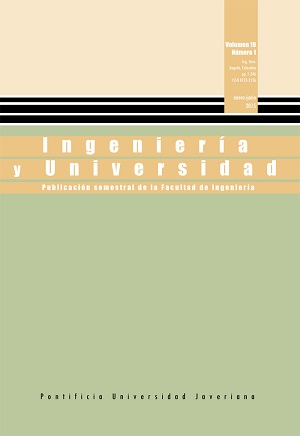Abstract
This paper presents a technical (base on exergy) and environmental analysis concerning an existing 50 MWe steam power plant located in the south of Santa Catarina state - Brazil, designed to operate with pulverized coal and modified to operate in co-firing process coal -biomass. In addition to the power plant, the study considered an extended boundary that involves the processes related to the obtaining, transport and handling both coal and biomass. The exergy analysis was focused in the second law of thermodynamics, while the environmental analysis followed the Life Cycle Assessment (LCA) methodology took into account as functional unit 1 MWh and the global warming impact category, following the IPCC GWP index over 100 years. For both cases (only coal and co-firing), the exergetic analysis indicated that the power plant is responsible for over 95% of the exergy consumption. Results indicated that for the case of operating only with coal, are emitted 1230 kg of CO2-eq per MWh, whereas for operation in co-firing, with a share of 10% of biomass on energy basis, the value of the issue it is 1103 kg CO2-eq per MWh.
Electric Power Research Institute, Biomass Co-firing guidelines. Palo Alto California: EPRI, 1997.
J. Hansson et al., “Co-firing biomass with coal for electricity generation. An assessment of the potential in EU27”, Energy Policy, vol. 37, pp. 1444-1455, 2009.
D. A. Tillman, “Biomass co-firing: The technology, the experience, the combustion consequences”, Biomass Bioenergy, vol. 19, pp. 365-384, 2000.
M. Hondo, “Life cycle GHG emission analysis of power generation systems: Japanese case”, Energy, vol. 30, pp. 2042-2056, 2005.
A. Odeah, T. Naser, and T. Cockerill, “Life cycle analysis of UK coal fired power plants”, Energy Conversion Management, vol. 49, pp. 212-220, 2008.
P. Spath, M. Mann, and D. Kerr, Life cycle assessment of coal-fired power production. Golden, Colorado: National Renewable Energy Laboratory, 1999.
F. Pereira, E. Bazzo, and A. Martins de Oliveira, “Biomass co-firing as an alternative technology for a clean coal electric generation in Brazil”, en 20th International Congress of Mechanical Engineering, Gramados, RS, Brazil, 2009.
R. Miyake, E. Bazzo, and M. Bzuneck, “Cofiring of rice straw and coal in a coal-fired utility boiler: thermodynamic analysis”, en 13th Brazilian Congress Thermal Sciences Engineering, Uberlandia, MG, Brazil, 2010.
G. Moreno-Contreras, J. Serrano-Rico y J. Palacios-Restrepo, “Desempeño de la combustión de desechos industriales en un reactor de lecho fluidizado burbujeante”, Ingeniería Universidad, vol. 13, no. 2, pp. 251-266, 2009.
F. Sebastián, J. Royo, and M. Gómez, “Cofiring versus biomass-fired power plants: GHG (greenhouse gases) emissions savings comparison by means of LCA (life cycle assessment) methodology”. Energy, vol. 36, pp. 2029-2037, 2011.
H. Ming-Che, H. An-Lei, and W. Tzai-Hung, “GIS-based biomass resource utilization for rice straw cofiring in the Taiwanese power market”, Energy, vol. 55, pp. 354-360, 2013.
S. Shafie, T. Mahlia, and H. Masjuki, “Life cycle assessment of rice straw co-firing with coal power generation in Malaysia”, Energy, vol. 57, pp. 284-294, 2013.
W. Schakel et al., “Comparative life cycle assessment of biomass co-firing plants with carbon capture and storage”, Applied Energy, vol. 13, pp. 441-467, 2014.
ISO, FDIS 14040, Environmental management. Life cycle assessment. Principles and framework. Ginebra: ISO, 2006.
ISO, FDIS 14044, Environmental management. Life cycle assessment. Requirements and guidelines Managements environmental. Analyse du cycle de vie. Ginebra: ISO, 2006.
T. Süffert, Carvão nos Estados do Rio Grande do Sul e Santa Catarina, Porto Alegre. Informe de Recursos Minerais. Série Oportunidades Minerais CPRM, 1997.
M. Yore, M. Summers, and B. Jenkins, “Development of a stubble cutting system for a combine harvester”, ASAE Paper Number: 01-1087. ASAE Annual International Meeting. Sacramento, CA, 2001.
IFK, “Report of rice straw and Brazilian coal analyses”, Institutfür Feuerungs -und Kraftwerkstechnik - Universität Stuttgart. Stuttgart, 2009. [en alemán].
J. Szargut, D. Morris, and F. Steward, Exergy analysis of thermal, chemical and metallurgical processes. New York: Hemisphere, 1988.
A. Bejan, G. Tsatsaronis, and M. Moran, Thermal design and optimization. Hoboken, NJ: John Wiley & Sons, 1996.
A. Restrepo, “Metodologia de análise e avaliação exergoambiental de plantas termoelétricas operando em combustão combinada carvão”, Tesis, Universidade Federal de Santa Catarina, Florianópolis, Brasil, 2012.
E. Hughes and EPRI, Biomass Cofiring: field test results. Palo Alto, CA: Electric Power Research Institute, 1999.
K. Heidi, H. Leif, and S. Anders, Update on impact categories, normalisation and weighting in LCA. Danish: Ministry of the Environment, Environmental Project Nr. 995, 2005.
This journal is registered under a Creative Commons Attribution 4.0 International Public License. Thus, this work may be reproduced, distributed, and publicly shared in digital format, as long as the names of the authors and Pontificia Universidad Javeriana are acknowledged. Others are allowed to quote, adapt, transform, auto-archive, republish, and create based on this material, for any purpose (even commercial ones), provided the authorship is duly acknowledged, a link to the original work is provided, and it is specified if changes have been made. Pontificia Universidad Javeriana does not hold the rights of published works and the authors are solely responsible for the contents of their works; they keep the moral, intellectual, privacy, and publicity rights.
Approving the intervention of the work (review, copy-editing, translation, layout) and the following outreach, are granted through an use license and not through an assignment of rights. This means the journal and Pontificia Universidad Javeriana cannot be held responsible for any ethical malpractice by the authors. As a consequence of the protection granted by the use license, the journal is not required to publish recantations or modify information already published, unless the errata stems from the editorial management process. Publishing contents in this journal does not generate royalties for contributors.


